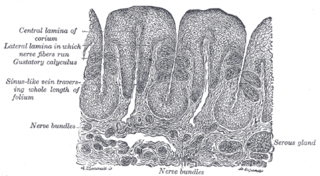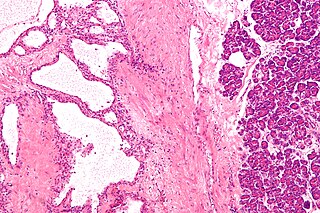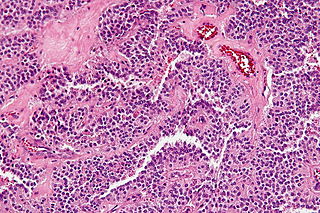Digestive enzymes are a group of enzymes that break down polymeric macromolecules into their smaller building blocks, in order to facilitate their absorption by the body. Digestive enzymes are found in the digestive tracts of animals and in the traps of carnivorous plants, where they aid in the digestion of food, as well as inside cells, especially in their lysosomes, where they function to maintain cellular survival. Digestive enzymes of diverse specificities are found in the saliva secreted by the salivary glands, in the secretions of cells lining

Surface epithelial-stromal tumors are a class of ovarian neoplasms that may be benign or malignant. Neoplasms in this group are thought to be derived from the ovarian surface epithelium or from ectopic endometrial or Fallopian tube (tubal) tissue. Tumors of this type are also called ovarian adenocarcinoma. This group of tumors accounts for 90% to 95% of all cases of ovarian cancer. Serum CA-125 is often elevated but is only 50% accurate so it is not a useful tumor marker to assess the progress of treatment.
The International Classification of Diseases for Oncology (ICD-O) is a domain-specific extension of the International Statistical Classification of Diseases and Related Health Problems for tumor diseases. This classification is widely used by cancer registries.

Serous glands contain serous acini, a grouping of serous cells that secrete serous fluid, isotonic with blood plasma, that contains enzymes such as alpha-amylase.

Cystadenoma is a type of cystic adenoma.
In physiology, the term serous fluid or serosal fluid is any of various body fluids resembling serum, that are typically pale yellow and transparent and of a benign nature. The fluid fills the inside of body cavities. Serous fluid originates from serous glands, with secretions enriched with proteins and water. Serous fluid may also originate from mixed glands, which contain both mucous and serous cells. A common trait of serous fluids is their role in assisting digestion, excretion, and respiration.
Pancreatic diseases include:

Acinic cell carcinoma is a malignant tumor representing 2% of all salivary tumors. 90% of the time found in the parotid gland, 10% intraorally on buccal mucosa or palate. The disease presents as a slow growing mass, associated with pain or tenderness in 50% of the cases. Often appears pseudoencapsulated.
Ovarian tumors, or ovarian neoplasms, are tumors arising from the ovary. They can be benign or malignant.
Mucinous cystadenocarcinoma is a type of tumor in the cystadenocarcinoma grouping.

Mucinous cystadenoma is a benign cystic tumor lined by a mucinous epithelium. It is a type of cystic adenoma (cystadenoma).

Intraductal papillary mucinous neoplasm (IPMN) is a type of tumor that can occur within the cells of the pancreatic duct. IPMN tumors produce mucus, and this mucus can form pancreatic cysts. Although intraductal papillary mucinous neoplasms are benign tumors, they can progress to pancreatic cancer. As such IPMN is viewed as a precancerous condition. Once an intraductal papillary mucinous neoplasm has been found, the management options include close monitoring and pre-emptive surgery.

Pancreatic serous cystadenoma a benign tumour of pancreas. It is usually found in the tail of the pancreas, and may be associated with von Hippel-Lindau syndrome.

Ovarian serous cystadenoma, also known as serous cystadenoma, is the most common ovarian neoplasm, representing 20% of ovarian neoplasms, and is benign.

A solid pseudopapillary tumour is a low-grade malignant neoplasm of the pancreas of papillary architecture that typically afflicts young women.
Ovarian cystadenoma is a cystic benign tumor of the ovary. Two types are recognized: serous and mucinous.
Pancreatic mucinous cystadenoma, also known as "mucinous cystadenoma of the pancreas", is a benign tumour of pancreas. It is one of the cystic lesions of the pancreas.

Cystic lesions of the pancreas are a group of pancreatic lesions characterized by a cystic appearance. They can be benign or malignant.

A pancreatic cyst is a fluid filled sac within the pancreas.

Bartholin gland carcinoma is an uncommon type of malignancy in the Bartholin gland that accounts for 1% of all vulvar malignant neoplasms. It is most common in women in their mid-60s. The tumor can become large before a woman is aware of symptoms. One of the first symptoms can be dyspareunia. In other instances a woman may find a mass or ulcer in the vulva area. Many clinicians assume that an enlarged Bartholin gland is malignant in postmenopausal woman until proven otherwise. The growth of the tumor can spread to nearby areas such as the ischiorectal fossa and inguinal lymph nodes. Approximately 50% of bartholin gland carcinomas originate from squamous cell carcinomas. Another uncommon characteristic of Bartholin gland malignancies is that the growth of a lesion originates from the three types of epithelial tissue present in the gland: mucinous, transitional, and squamous.











